Quando o arquivo do feed estiver pronto, hospede-o em um local seguro. O Google busca o feed regularmente, normalmente uma vez por dia, para garantir que seu conteúdo permaneça atualizado. Trabalhe com seu representante do Google para compartilhar os detalhes de hospedagem e o melhor momento para buscar o feed do local hospedado.
Recomendações para hospedar o feed
Embora seja a critério do provedor de dados determinar a melhor maneira de hospedar o feed e como ele é estruturado no local hospedado, confira algumas recomendações sobre como o feed deve ser estruturado para permitir uma busca perfeita.
- Crie uma pasta chamada "latest" (sem distinção entre maiúsculas e minúsculas). Verifique se essa pasta é atualizada diariamente com os arquivos de feed JSON e contém apenas os arquivos que o Google precisa buscar no dia.
- Não crie subpastas na pasta mais recente. Mantenha a hierarquia plana, ou seja, todos os arquivos JSON precisam estar presentes diretamente na pasta "latest".
- Opcionalmente, você pode armazenar pelo menos o feed dos últimos 30 dias em pastas com o nome "data-hora". Isso pode ser útil caso seja necessário rastrear um problema com a versão anterior do feed ou consultar metadados fornecidos anteriormente. O Google não vai usar essas pastas.
- Verifique se a pasta "latest" não tem arquivos vazios/com tamanho de 0 KB.
- Verifique se o Google sempre tem acesso à pasta "latest" para que os arquivos possam ser buscados de maneira seamless.
- Caso o Google solicite um feed de preparação, crie uma pasta separada para hospedar o feed. Por exemplo, se a hierarquia do feed de produção for ../latest/, você poderá criar uma hierarquia diferente para o feed de pré-produção, por exemplo, ../staging/latest/.
Métodos de hospedagem
A tabela abaixo lista os métodos de hospedagem de feed compatíveis e os detalhes necessários para compartilhar com representantes do Google.
| Método | Detalhes obrigatórios | Suporte para autenticação |
| Google Cloud Storage (GCS) |
|
|
| HTTPS |
|
|
| SFTP |
|
|
| AWS S3 |
|
|
Depois de fazer o upload dos arquivos de feed usando um dos métodos acima, entre em contato com a equipe de Ações de mídia para analisar os arquivos.
Hospedar o feed no Google Cloud Storage
As etapas a seguir demonstram como fazer upload de um arquivo de feed no Google Cloud Storage:
Faça login no console do Google Cloud Platform e clique no menu suspenso Selecionar um projeto.

Na janela pop-up, clique em NOVO PROJETO.

Dê um nome ao novo projeto e clique em CRIAR.
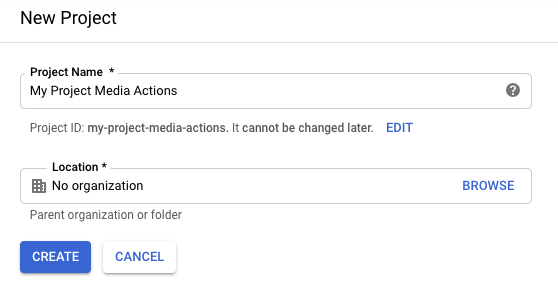
No menu de navegação, clique em Storage > Browser.
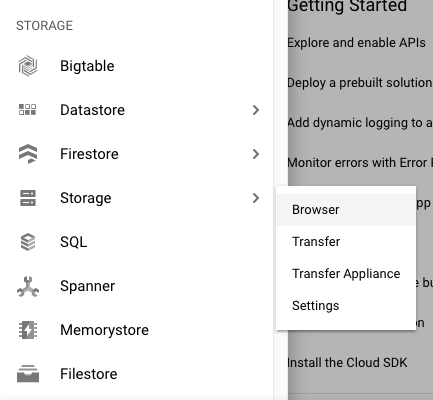
Se você ainda não se inscreveu no Google Cloud Storage, clique em Inscrever-se para um teste sem custo financeiro para iniciar o teste. Você pagará por esse serviço apenas depois de acumular custos. O pagamento será efetuado por meio de uma cobrança automática quando você atingir o limite para faturamento ou 30 dias após o último pagamento automático, o que ocorrer primeiro.
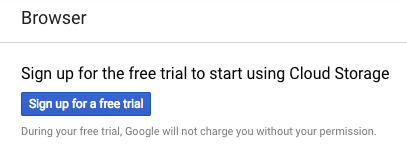
Depois de se inscrever para um teste sem custo financeiro, atualize o navegador para atualizar a tela.
Clique em Criar bucket.
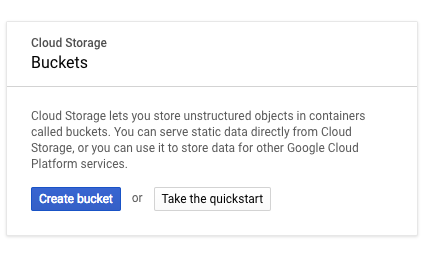
Nomeie o bucket e clique em Criar.

Na página "Detalhes do bucket", clique em Fazer upload de arquivos.

Faça upload do arquivo de feed.

Na página "Detalhes do bucket", clique em Permissões.

Clique em Adicionar membros.
No campo Novos membros, insira o seguinte endereço de e-mail:
088794101-100000002-account@partnercontent.gserviceaccount.comNo menu suspenso, selecione Visualizador de objetos do Storage e clique em Salvar.
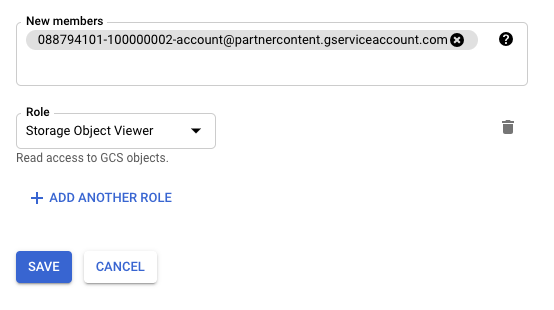
Depois de fazer o upload do arquivo de feed para um sistema host, entre em contato com a equipe de ações de mídia para analisar o arquivo.
